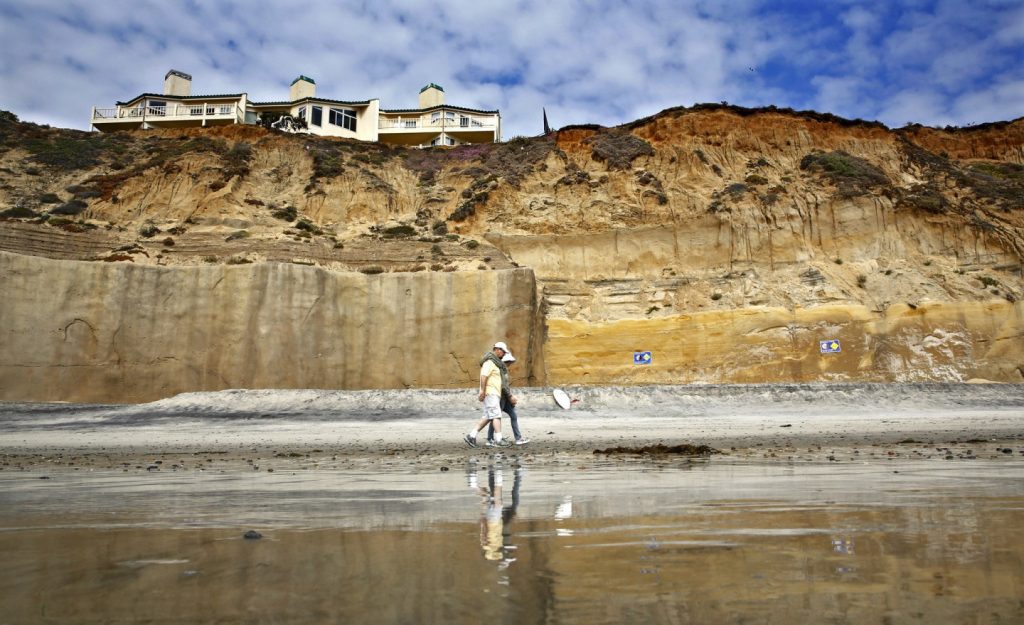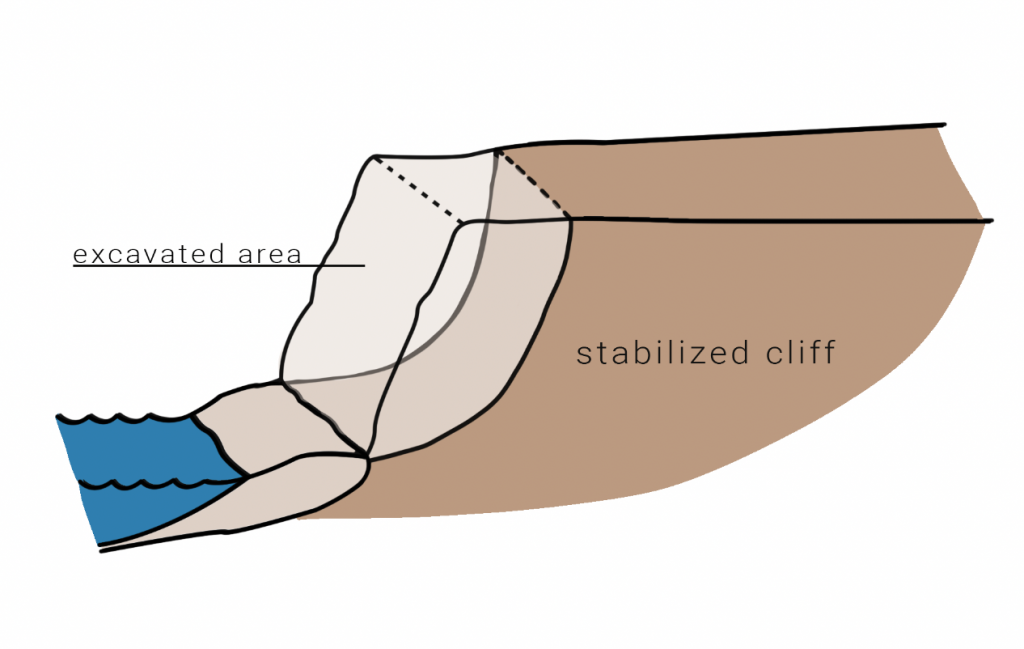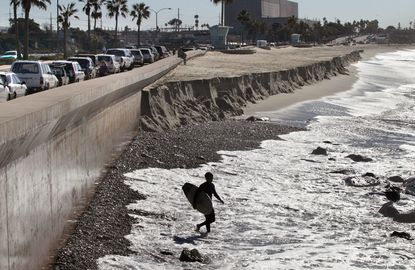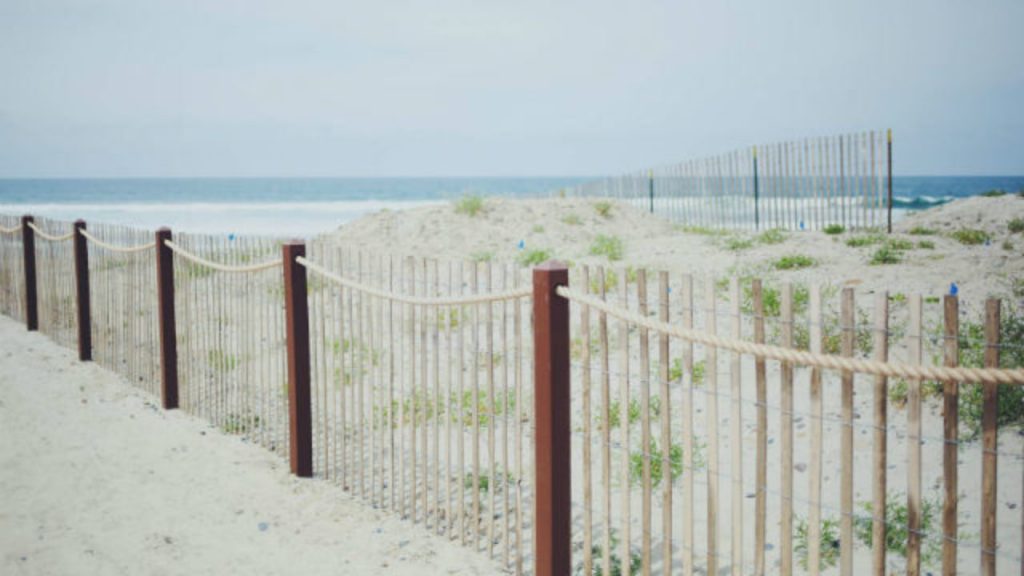
When you walk along San Diego beaches, you can often see coastal armoring (seawalls and riprap) along the cliffs and in front of beachfront properties. Even though armoring is commonplace, these structures are often built to protect private homes while whittling away at the public beaches we know and love.

Seawalls and rip rap narrow the public beach
Seawalls are concrete structures that hold coastal cliffs back from natural erosion - an important source of beach sand - and riprap is made of loose rocks meant to lessen the impact of waves on coastal cliffs.

Unfortunately, the benefits of seawalls and riprap are privatized, and the more our coast becomes armored, the faster we lose our walkable beaches (see Figure 1 below). Here's a run down of how seawalls and rip rap take away the beach:
- Seawalls and riprap occupy beach space that would otherwise be enjoyed by the public. Their very presence reduces the width of our walkable beaches. For example, riprap can take up as much as 30 to 40 feet of beach width.1
- Seawalls and riprap lock potential beach sand in place on the cliffs, removing an important source of natural sand replenishment for beaches. A natural coastline, where waves bounce off unarmored cliffs, would instead slowly contribute sand to the public beaches. With many of California’s rivers already dammed amidst the approaching threat of sea level rise, we cannot afford to cut off other sand supplies.
- The most detrimental effect of seawalls is passive erosion. When a hard structure is built along a shoreline that is already undergoing long-term net erosion, the shoreline will eventually and naturally migrate landward, behind the structure (Figures 1 and 2 below). The end result is the beach in front of the seawall or hard structure is gradually lost as the water deepens, and the natural shoreline migrates landward. As sea levels continue to rise, beach loss will accelerate, and beaches and reefs will drown.

Sand replenishment is an expensive, short-term bandaid
Some coastal armoring advocates look to sand replenishment as a cure-all to armoring’s woes. However, pumping sand from the ocean or from other places onto the shore is difficult (the sand grain and size has to match each beach’s sand) and prohibitively expensive (replenishment costs millions, and has to be repeated over time).
With so many beaches suffering from erosion, there isn’t enough sand for all the cities that want to artificially replenish their beaches. Placing sand on beaches can offset sand impeded by dams, groins and jetties. However, placing an excess of sand on beaches - especially those with reefs and seagrass - will destroy vital coastal resources, including surf breaks.
Seawalls do NOT make beaches safer
Some proponents of coastal armoring argue that seawalls add to public safety. However, the opposite is true: seawalls cause beaches to disappear over time. The narrower a beach becomes, the less safe space there is for the public to walk, run, or otherwise enjoy the beach.4
While seawalls may temporarily prevent lower bluff collapses at sea level, they won’t necessarily prevent upper bluff collapses. For example, the upper bluffs in North County San Diego consists of largely unconsolidated sediment and is known to be particularly unstable.
If public safety is a genuine concern for unstable bluffs, one solution is to follow what ski resorts do when snow is unstable: avalanche control. Upper bluffs can be stabilized by triggering a collapse until the material is at a stable angle. This approach presents a choice between moving 1 row of houses back to accommodate stability, or destroying the beach below for visitors from 10,000 rows of houses in the name of preserving beachfront property.


Armoring protects beachfront structures at the cost of the public beach
The known costs of seawalls and riprap, combined with the downfalls of short-term fixes like sand replenishment, pose the question: “Who are these seawalls for?”
Seawalls and riprap protect properties built at the edge of coastal cliffs or on the shoreline, but they don’t protect or preserve the public beaches. In fact, coastal armoring occupies public beach space and typically only benefits private property owners. As sea levels continue to rise, the public beach will be further destroyed through passive erosion losses.
Armoring usually privatizes the benefits for coastal homeowners, while passing on the costs to the public.

There are better ways to protect and preserve public beaches
Living shorelines can replace hard armoring with natural plants to reduce beach erosion in some areas, but they may be difficult to implement on bluff or cliff-backed beaches.
Preserving and restoring wetlands and dunes can help preserve the existence of these fragile but important ecosystems, while also helping to reduce storm impact on coastal communities.
If needed, unstable bluffs should have buffer zones in front. If the stability is of grave concern, avalanche control can occur to make the slope stable.
Thoughtful coastal development is an important aspect of preserving the public beach for decades to come. Hard armoring would not be necessary if homes and buildings were not built so close to the cliffs and ocean, and future planning decisions will be critical in determining the fate of the beach. For example, when any development or redevelopment occurs next to the beaches, the buildings should be adequately set back far enough from the cliff edge to prevent a false need for a seawall.6
Beach erosion is an issue facing all Californians, as over 80% of the California coastline is eroding7. The narrower the beaches get, the less space we have to walk, run, surf, or enjoy this vital public resource. Beach-dwelling animals and wildlife are also impacted as their habitat disappears due to sea level rise and accelerated erosion8.
California’s beloved public beaches are protected by law, but they continue to face threats to their very existence. The next time you surf or walk the beach, try looking at coastal armoring in a new light. Is armoring worth the cost of our public beach?

For further reading, we recommend the Managing Coastal Armoring and Climate Change Adaptation in the 21st Century report by Stanford Law.
Citations
1 Garry Griggs, California’s Retreating Coastline: Where Do We Go From Here? (2005).
2 Cal. Coastal Comm’n, Handouts for Senate Budget Subcommittee 2, Coastal Climate Adaptation, 12 (Mar. 20, 2014), available at https://www.coastal.ca.gov/climate/Handouts_SenateSubcommittee2_Mar20.2014.pdf.
3 Hapke, Cheryl & Adams, Peter & Allan, J. & Ashton, Andrew & Griggs, Gary & Hampton, M. & Kelly, J. & Young, Adam. (2014). Chapter 9 The rock coast of the USA. Geological Society, London, Memoirs. 40. 137-154. 10.1144/M40.9.
4 STAFF RECOMMENDATION ON CITY OF SOLANA BEACH MAJOR AMENDMENT LCP-6-SOL-16-0020-1 for Commission Meeting of May 11, 2017
5 Johnsson, Mark. (2003). Establishing development setbacks from coastal bluffs - Briefing for the California Coastal Commission
6 CA Pub Res Code § 30253 (2016)
7 Living with the California Coast, (Gary B. Griggs & Lauret Savoy eds., Duke University Press, 1985); Gary B. Griggs, California’s Coastline: El Niño, Erosion and Protection, in California’s Coastal Natural Hazards: Santa Barbara, California, University of Southern California Sea Grant Program 36, 36-55 (L. Ewing & D. Sherman eds., 1998).
8 Hubbard, David. “Beach Inhabitants.” Explore Beaches, University of California, Santa Barbara, explorebeaches.msi.ucsb.edu/climate-change/beach-inhabitants.
